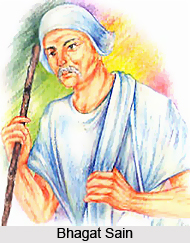 Bhagat Sain was the saint in India, who enjoyed a great name and fame from the so-called low caste Indians, after the death of Kabir. There is a bit of controversy about the exact year of Bhagat Sain`s birth, while most of the scholars say that he was born in the year of 1390 in Karnataka, some of the other scholars argue the year to be 1343. Bhagat Sain was one of the greatest followers of Ramanand of Prayag, who was the pioneer of Bhakti Movement in Northern India.
Bhagat Sain was the saint in India, who enjoyed a great name and fame from the so-called low caste Indians, after the death of Kabir. There is a bit of controversy about the exact year of Bhagat Sain`s birth, while most of the scholars say that he was born in the year of 1390 in Karnataka, some of the other scholars argue the year to be 1343. Bhagat Sain was one of the greatest followers of Ramanand of Prayag, who was the pioneer of Bhakti Movement in Northern India.
Bhagat Sain born in a low caste family and he was a barber by birth. However, his family background could not put on any obstacle on his way to spiritualism and though he used to visit the royal palace to massage the king`s body, he remained absorbed in Divine name, at nights.
There is a strange and wonderful story about the childhood of Bhagat Sain that suggests that one day Sain missed a visit to the royal palace because he was very much involved in serving his guests. However, in spite of his being busy with the guests, a man reached the royal place in time and did his job. In later investigation, it was found that it was some mysterious man, who did the job for Bhagat Sain.
Bhagat Sain was such a saint who literally devoted his entire life in the name of God and he has also spread his own thoughts and knowledge among the masses. He has depicted a lot of hymns during his life and one of Sain hymns is as follows: "I am sacrificed into them who are ever absorbed in the aarti of the supreme Lord. O God it is only Thy devotees who recognize you, remember you, and sing your praises". He died at a very young age of only 50 years in the year of 1440.
This article is a stub. You can enrich by adding more information to it. Send your Write Up to content@indianetzone.com




















